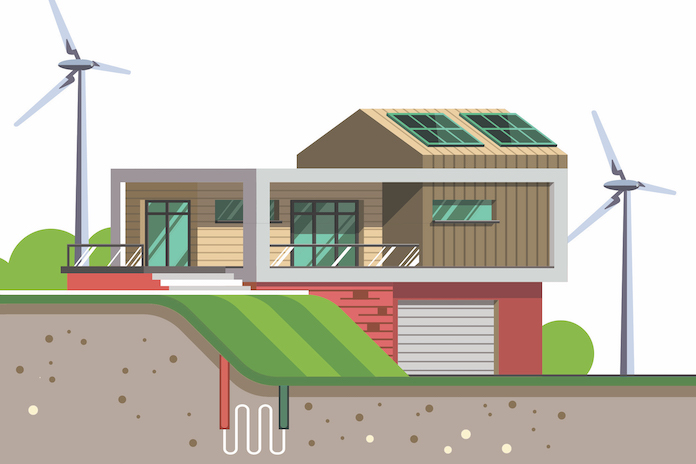
With each month that passes, the UK’s lofty 2050 net zero carbon target becomes more daunting. But through grants and incentive schemes, the government is desperate to increase the take-up of low carbon energy technologies. Which are the best options though? Jamie Harris reports
The ‘other’ global emergency hasn’t gone away. The climate crisis has continued its relentless pursuit of this planet during the last eight months in which the coronavirus pandemic has kept hold of our collective attention.
But with businesses, local authorities and governments alike declaring a climate emergency last year, and with the UK government enshrining in law its net zero carbon 2050 target, the focus for several industries, including the carbon-heavy built environment sector, is to continue (or begin) enacting sustainable practices.
Renewable energy generation on site is an increasingly fundamental component for individual homeowners, larger-scale housebuilders and commercial developers alike to reduce demand on the national grid and generate clean energy that is used in the most efficient way.
The technologies range wildly in price, running costs, output and savings, from the cheaper solar PV panels to the more expensive ground source heat pumps, air source heat pumps and biomass boilers. Many are included in the tangled web of government grants available, such as the recently announced Green Homes Grant, although some technologies miss out on certain funding pots.
For the individual, it’s a complex market: which technology provides best value for money? For the wider sector, it’s more complicated: which technology is best value for money and is most likely to drive the UK towards net zero carbon in the next 30 years?

Solar panels
Solar photovoltaic (PV) panels have been around for decades, but thanks to advances in photovoltaic technology, the cost is continuously decreasing, while the amount of electricity generated is heading in the other direction. With relatively inexpensive capital costs – a typical array on a domestic property costs around £6,000 – the sight of a solar PV array on the roofs of domestic buildings is now commonplace.
Solar PVs have an incredibly long lifespan – some can provide clean energy for up to 30 years – generally do not require planning permission, and under the Smart Export Guarantee (SEG) building owners can export electricity generated through panels to the national grid for a small sum.
“There are no running costs for this – these are just savings that can be made,” explains Luke Osborne, energy and emerging technologies solutions advisor at the Electrical Contractors Association (ECA).
Despite its relative affordability, the government has decided against including solar PVs in its Green Homes Grant scheme, introduced this summer to offer £5,000-£10,000 towards low carbon technologies. Solar water heating, however, is included.
Solar water heating – also known as solar thermal – collects heat from the sun to directly heat up water using a hot water cylinder. This system is then connected to a compatible boiler, which can be used to up heat, particularly in winter months.
In relation to solar PV technology, solar thermal is – at least until the new grant impacts the market – relatively rare, says Barny Evans, head of energy, waste and sustainable places at consultant WSP. “Solar panels are so cheap, relatively flexible and easy to plug in – and you can still use it to help provide hot water,” he explains.

Solar
- Typical installation cost: £6,000
- Average generation: 3,600kWh
- Typical savings: £360 per year
- Grants/funding: Roughly 5p per kWh through exporting via Smart Export Guarantee (not included in Green Homes Grant)
- Planning issues: Planning not normally required – distribution network operator (DNO) should be notified post-installation (prior approval required for larger systems)
- CO2 impact: Average generation creates a CO2 saving of 756kg per year
Source for statistical information: ECA (unless indicated otherwise)
Ground and air source heat pumps
If an energy generation technology could ever be described as being ‘in vogue’ in 2020, ground source and air source heat pumps would be the most likely candidate. Heavily backed by government funding for part of the upfront costs (see Funding options, below), both were covered by the Renewable Heat Incentive (RHI) scheme, are currently covered by the Green Homes Grant, and are thought likely to be included in a future Clean Heat Grant scheme.
While heat pumps require power, they generate heat using much less primary energy than other technology, such as gas boilers. Through extracting heat from outdoor air (air source heat pumps) or under ground (ground source heat pumps) and transferring it through a refrigerant, the heat is then released to the home’s central heating system.

Ground source heat pumps
- Typical installation cost: £15,000-£20,000
- Average generation: 1kWh electricity will give around 4kWh in heat
- Typical savings: Dependent on property and boiler it is replacing – ranges from £500-£1,500 per year (Source: Energy Saving Trust)
- Grants/funding: RHI, GHG, CHG (£5,000 capital costs)
- Planning issues: If total building demand is less than 13.8kVA, then install and inform DNO within one calendar month, if more than 13.8kVA then prior approval is required
- CO₂ impact: Gives savings of 400% on equivalent electricity
Air source heat pumps are applicable to more buildings, as ground source heat pumps require more space, particularly if installed on an existing building. Osborne thinks that once Building Regulations change, air source heat pumps will become the default option. He says: “The current Building Regulations are using old assessments for energy ratings of dwellings which are based on historic data, which are not realistic any more.”
This data categorised grid electricity usage as producing higher emissions than it does today, largely thanks to the decarbonisation of the national grid.
The updated methodology for calculating energy use in new residential developments will come into effect when the revised Building Regulation part L is published. Once this is updated, low carbon heating options will be more attractive. The Clean Heat Grant, which is currently in consultation, will support their installation.
Says Osborne: “The government intends on installing 600,000 a year by 2030, but the Committee for Climate Change are recommending 1,000,000.”
Ultimately the UK’s net zero carbon target of 2050 will not be met unless new buildings are designed and constructed with this goal at their heart. The sprawling existing stock in the UK – 80% of which will still be standing in 30 years’ time – also requires a radical retrofit programme.
WSP’s Evans points out that heat pump technology is “phenomenally efficient” for new builds but less so when retrofitted on draughty, older buildings. “They work much more effectively at low temperatures. But if you are looking at a Whitehall-style office built in the 1800s, with no insulation and single glazing, you need to run a much hotter heating system to maintain the internal temperature – heat pumps are less effective, and in some cases, unviable.”

Air source heat pumps
- Typical installation cost: £8,000-£12,000
- Average generation: 1kWh electricity will give around 3.5kWh in heat
- Typical savings: Dependent on property and boiler it is replacing – ranges from £400-£1,350 per year (Source: Energy Saving Trust)
- Grants/funding: RHI, GHG, CHG (£5,000 capital costs)
- Planning issues: If total building demand is less than 13.8kVA, then install and inform DNO within one calendar month, if more than 13.8kVA then prior approval is required
- CO₂ impact: Gives savings of 350% on equivalent electricity
Less favourable schemes
There are several other options available to domestic and commercial buildings to generate low carbon energy, but many are hampered by operational and logistical issues.
Domestic wind turbines can only be installed on a detached house and comply to strict planning regulations.
Says WSP’s Evans: “On a project level, they are pretty unusual – it needs to be a very bespoke location, such as on an industrial space where there is a lot of land available.”

Domestic wind turbines
- Typical installation cost: £10,000 (2.5kW) (£30,000+ for 6kW+)
- Average generation: Typically 10,000kWh per year (depending on wind speeds)
- Typical savings: Could save £250 per year on energy bills
- Grants/funding: None. (May be eligible for SEG)
- Planning issues: If mounted on a building, must be on a detached building. Must comply with micro generation certification scheme planning standards
- CO2 impact: Savings of 2.8 tonnes a year (on 10,000 kWh production)
Biomass systems, which burn wood pellets to provide heat, require plenty of space, particularly for the hopper, which stores the fuel. They are typically good for off-grid and draughty buildings as they provide a higher temperature output. They are effectively carbon neutral, but there are other factors to consider, says the ECA’s Osborne.
“New trees are planted to offset those used, but often these are imported from countries such as Canada, so you then have carbon transport miles to consider,” he explains.
Biomass boilers have also caused problems on a non-domestic scale. Larger boilers were installed in schools across the country at great costs – up to £100,000 each – as part of the government’s Building Schools for the Future programme.
Austen Bates, head of building performance at Ramboll, explains that schools often installed a larger boiler than necessary in order to get low carbon funding for the school.
He says: “A large biomass boiler went in to get to your 70%-of-energy-generated-from-biomass tick. I’ve seen it in a number of schools where they are switched off because they are too expensive to run and too big to maintain.”
Combined heat and power (CHP) captures waste heat from the electricity generation and uses it for thermal energy, such as hot water.But because of the decarbonising grid, explains Rob Barnes, energy strategy lead at Arcadis, CHP is increasingly falling down on CO2 emissions. He says: “The government is pulling back on their support for it because it appears not to be the right option for the future.”

Biomass
- Typical installation cost: Pellet £6,000-£12,000, Log batch £5,000-£10,000
- Average generation: Typically 10,000kWh per year (depending on wind speeds)
- Typical savings: Could save £1,000 per year on energy bills (Source: Energy Saving Trust)
- Grants/funding: RHI, GHG (£5,000 upfront cost)
- Planning issues: Generally do not require planning permission
- CO2 impact: Savings of 14.3 tonnes a year (when replacing older systems)

A holistic approach
For new and existing buildings alike, a combined approach is essential for reaching net zero carbon. Passive measures aimed at reducing energy demand through improving a building’s fabric and a whole-life focus on reducing the embodied carbon in the construction and in-use phases of a building’s life are important components in hitting the net zero target.
Andy Sutton, co-founder and director of design and innovation at green housebuilder Sero Homes, stresses that energy balancing – the art of managing energy demand on the national grid – is equally as important as reducing usage or generating heat on site. Energy storage solutions, such as batteries, can store the energy generated at times of low demand instead of sending it direct to the grid, and be available to meet local demands when they arise.
Says Sutton: “[Onsite generation technologies] shouldn’t be installed without balancing technologies. PVs are the culprit here; they provide generation direct to the grid at times of low demand but high grid renewable generation in the middle of the day.
“As part of an overall plan for the individual home, low/zero carbon technologies such as heat pumps, home batteries and thermal stores and PVs can support fabric measures to deliver an optimised retrofit.”
The generation technologies on the market are becoming more affordable and more viable. With the government’s funding schemes and the desire for low carbon heat to become the main player in the market rather than a niche outlier, the UK may yet make commendable progress towards becoming net zero carbon.
When considering these alongside the UK’s approach to electric vehicles, energy storage and retrofitting existing buildings, the ambition is admirable, however disconcerting the journey looks.

Funding options: Government incentives are encouraging the adoption of low-carbon technologies
There are now a raft of policies and incentive schemes from the UK government urging the nation to adopt these technologies already in place and more to follow.
The Renewable Heat Incentive (RHI): Introduced in 2014 to incentivise the use of renewable heat. Participants receive quarterly payments across seven years for the renewable heat produced. The scheme will be ending in the next 12-24 months but it is currently still available for both domestic and non-domestic applicants.
Green Homes Grant (GHG): Offers up to £5,000 for individuals to improve the energy efficiency of their home, although the offer only stands until March 2021. Low income households can claim for up to £10,000. Air or ground source heat pumps, solar thermal and biomass boilers are covered by this scheme.
Clean Heat Grant (CHG): A consultation has now closed on this scheme, set to follow on from the RHI, aimed at phasing out high carbon, fossil fuel heating. The scheme is designed to support upfront costs for heat pumps and biomass installations in households and small non-domestic buildings. Not expected to roll out until 2022.
Smart Export Guarantee (SEG): Came into force in January 2020. Licensed electricity suppliers are now obliged to offer a tariff and make payments for low carbon electricity generators exporting to the national grid. Includes solar PV, wind power, micro combined heat and power (CHP) and others. The scheme replaced the Feed-in Tariff, which closed to new applicants in 2019.
Comments
Comments are closed.











‘Domestic Scale’ wind turbines are extremely unlikely to net any domestic property owner 10MWh a year. In typically sheltered zones you might get a tenth of that from a 5kW turbine, and that, at 12m high, is barely on a domestic scale, certainly not something you could put in a garden of under an acre. On a normal to severe site you might get up to half that – 5MWh a year – but you would be very lucky if you did. From a 1kW turbine – the sort you could put in a garden with only some black looks from neighbours, rather than start a small war – you would be lucky to get 500kWh.p.a. A 10kW turbine needs a taller mast to take it out of ground effect, and doesn’t qualify as a domestic item.
The low hanging fruit of solar electric has been put out of bounds by the UK government due to the need for storage, which they will not provide on the scale needed to smooth out the diurnal effect. You might solve some home heating provision with ground source heat pumps, but there are far better ways of addressing the issue of diurnal energy storage, and heat pumps are not one of them.
The most obvious one is to use surplus solar electric to drive a new generation of methane from waste plant – from micro to city scale – and store the resultant gas in the national gas grid. That takes methane out of the biosphere, where it will go otherwise (much solar energy ends up as cellulose in plants, and that decay, as plant and animal waste, creates methane), and cut emissions dramatically. That gas then can smooth out the diurnal energy supply:demand curve and the end product – CO2 – is many times less harmful. This is a natural process – part of the carbon cycle – and we need to get a grip on that, which at present we do not.